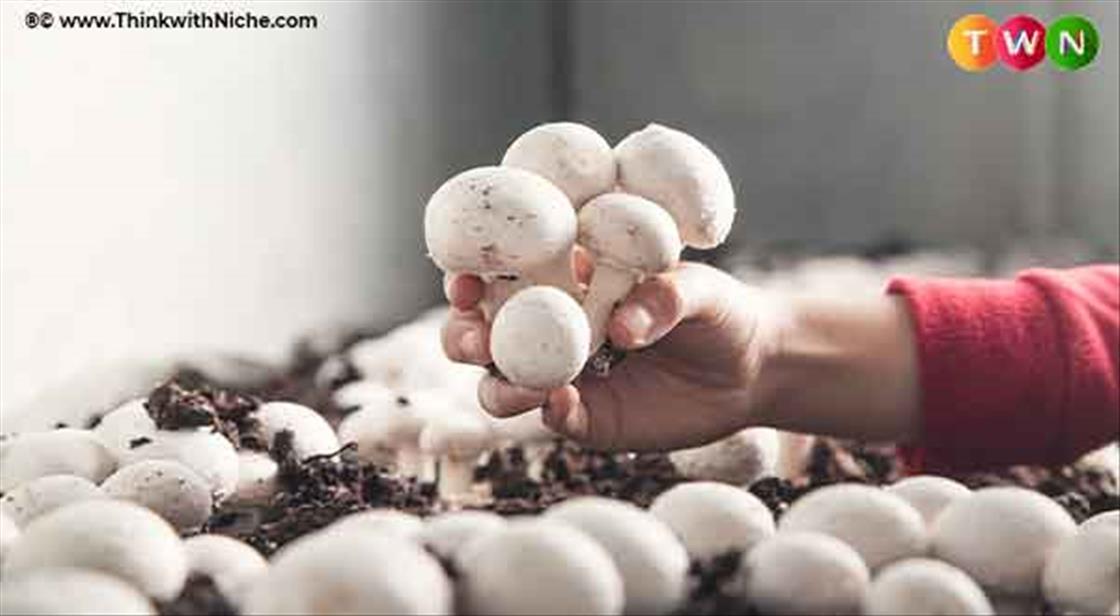Grow Mushrooms at Home and Start a Sustainable Business

Blog Post
Mushroom farming is not anything new. It began many years ago, and currently, it is now one of the fastest-growing farming industries. Over the next five years, the expected growth rate for the company is 10%. So, let’s see how it’s possible to start a mushroom business from home. You must read on. #ThinkWithNiche
How to start a mushroom farm
Mushroom farming, which started many years ago, is today one of the fastest-growing agricultural businesses. As a business, the growth rate is expected to be 10% over the next 5 years. The United States is the second-largest producer in the world. What is a mushroom farm? Fungi are fungi that grow and live in organic matter. Mushroom farming is also known as mushroom farming.
Why you should start a large scale mushroom growing business
- Mushrooms can be grown all year round. Mushrooms grown indoors should not be directly affected by weather conditions, which is a typical problem in agriculture.
- Waste can be recycled. Protein-rich foods are in demand, and mushrooms are high in protein.
- With a good business plan for expansion, you can start small and grow.
- Empty industrial buildings have the potential to grow fungi in urban agricultural environments.
Mushroom industry in the United States
In 2020, the mushroom industry was valued at about $46 billion. The compound annual growth rate is expected to be 9.5% from 2021-2028. Mushrooms after harvest have a short shelf life, starting from 13 days. Perhaps this is why the highest growth rates should be in processed mushrooms, such as dried, frozen, canned, pickled, and powdered.
Mushrooms are fundamental for their healthful and helpful worth, yet additionally for their product esteem. It doesn't require a ton of room or land, which is the reason it is available everywhere. Mushroom development has a ton of potential as a wellspring of income. It flourishes without even a trace of daylight, benefits from natural matter, and doesn't need prolific soil to flourish. Air space is utilized notwithstanding floor space, bringing about expanded usefulness.
Mushroom development can be viewed as an elective type of revenue for people who want to participate in it, especially during their off time.
However, you may wonder why mushrooms are so popular. The most significant benefit of this venture is that mushrooms can transform nutritionally worthless materials such as wheat or paddy straw into nourishing delights. It also allows for the recycling of agricultural wastes like dung and chicken manure, which would otherwise pollute the environment. Mushrooms are high in protein, vitamins, minerals, and folic acid, as well as being a useful supply of iron for anemic people. Mushroom has the same protein quality as animal protein. Besides, mushrooms provide lysine and tryptophan protein, which are lacking in vegetables and cereals. You can grow mushrooms at any time of the year. Mushrooms are grown indoors. Therefore, they aren't affected by the weather as much as other crops are. Mushroom farming is also far less expensive than other types of farming. Of course, the cost of starting a mushroom farm varies greatly depending on the size of the enterprise at the outset. In the farming sector, beginning crops have a low percentage of that.
Here are a few measures to take:
1. Know the Basics
Even though mushroom farming is rather simple, you must understand all the fundamentals before you begin. For starters, you should be aware that there are three major varieties of mushroom harvest: button mushrooms, oyster mushrooms, and paddy straw mushrooms. These mushrooms develop in diverse ways employing different techniques and approaches. To cultivate mushrooms, a special bed known as a compost bed is prepared. You'll need a concrete floor, as well as enough ventilation and temperature control. You'll also need a good-sized outdoor space, preferably with a concrete floor.
Then you must be well-versed in all terms related to mushroom farming. There are a few key terms to understand when it comes to mushroom cultivation.
The first is Spores. Millions of tiny spores are produced by mushrooms. The spores are found on the gills that run along the cap's underside. The spores have the appearance of seeds.
Then you'll want to learn about Spawn. Mycelium refers to the spores that have been prepared. Mycelium is mixed with water and added to sterilized grains like millet, rye, or wheat. The most common grain used is rye. Then it's known as spawn. Spawn can be stored in the refrigerator for up to three months. The process of getting the spores to germinate is known as spawn production.
2. Make A Proper Planning
For any start-up, planning is essential. As a result, plan of time before diving in. Begin by making a list of basic requirements for the mushroom-growing enterprise. You'll need to be able to get to surrounding markets. You'll need an odor-control strategy for compost on the deck outside. Choose which edible mushrooms you want to grow from the three types available. Smooth white, off-white, and brown are the three main variations. Each variety contains eight strains. Plan for the space and make a list of the supplies you'll need.
3. Create a Proper Space
For mushroom farming, you'll require a lot of space, both inside and out. According to the instruction, you'll need an indoor facility with reasonably priced ventilation, temperature control, and lighting. Temperature controlled room is very necessary to pile the compost. Compost piles are usually six feet wide, six feet tall, and, if necessary, six feet deep. Growth becomes anaerobic as a result of compression, allowing viruses, bacteria, and fungi to thrive.
You can also select an outdoor location. Large enough outside areas for compost piles. However, you must consider the compost heaps' proximity to residential areas, as the contents of the compost piles can emit aromas. Outdoor compost piles must also be covered to avoid being harmed by rain.
4. Collect Ingredients and Equipment
Horse manure and wheat straw are the most common composting ingredients. Because straw is only available during certain seasons, you must buy it when it is available and store it on your land.
- Gypsum is also included in the composting process. Gypsum aids in the air permeation of the compost.
- Mycelium – Mycelium is the spores that begin the growth of mushrooms. The spores are produced by gills beneath the mushroom top. The process of getting the spores to germinate is known as spawn production. Mycelium refers to the spores that have been prepared. Spawn is a grain or seed that contains mycelium from mushrooms.
- Peat Moss – Once the compost is in place in the incubation room, peat moss is added as a top layer.
- Supplements — In the past, mushroom producers would add nitrogen supplements to the compost, such as peanuts, cotton, and corn distiller grain. That is still done the same way it was done years ago. However, time-released vitamins are now available commercially.
- Substrate - You'll need to figure out a way to get the main elements regularly. Each component is necessary for the substrate, or compost basis, to be properly prepared.
5. Follow the Farming Process
Compost preparation is crucial and more complex than you might believe.
- Get Your Spawn And Mix — Compost mixes usually contain about 85% manure and chaff, as well as additional ingredients such as gypsum. You will need a spawn to start growing. You can breed on sterile culture media or purchase ready-to-transplant uterine material from a single source.
- Substrate Preparation - You also need to purchase a substrate. Many growers depend on hay grasses or wood pieces to grow their crops. The most common method is to use hay grass. You will need a hay-grass that can be cut into small pieces, then you need to moisten the hay-grass, now you need to boil them in water, boil for another half hour, then drain it and let it dry in a cool place.
- Plastic Bag Packaging - It’s now time to fill the plastic bags with straw and spawn. Fill the plastic bag with two or three inches of straw, then lightly sprinkle the spawn on top. Wait until the bag is almost full, then close the lid and punch a hole through it.
- Incubation – Now start incubation. Maintain a temperature around 78 degrees Fahrenheit. The bags are placed on the shelf. Remember to block any potential sources of natural light from entering the room. Close all cracks and windows. Move on to the next step as soon as you notice a tiny pinhead fungus near the vents in your bag.
- Fruiting – You will need a lot of moisture in the fruiting space. It will maintain temperatures between 65 to 70-degrees Fahrenheit. In contrast to the incubation room, you'll require a lot of natural light for at least 12 hours every day. Move the bags to a cold spot for a day to shock your mycelium into fruiting, and then return them to the fruiting room. Then cut the neck of the bag to allow the fungus to grow.
- Harvest - When your mushroom caps have completely unfurled, it's time to harvest. To do so, twist the stem as close as possible to the growing block.
6. Get Ready to Market your Mushrooms
Now, it's time to put your mushrooms up for sale. As far as food goods go, mushrooms are in high demand. As a result, the mushroom industry is extremely competitive. Your company needs to be promoted.
To broadcast your first and ensuing mushroom crops, utilize online media. Utilize online media to advance your site and compose websites. Expound on the wholesome worth of the mushrooms, just as the advantages they give, and notice your mushroom business. Cafés, supermarkets, ranchers' business sectors, and food social orders are on the whole where you can sell your mushrooms. Search for where you can sell mushrooms, and those are great for you.
You May Like
EDITOR’S CHOICE












